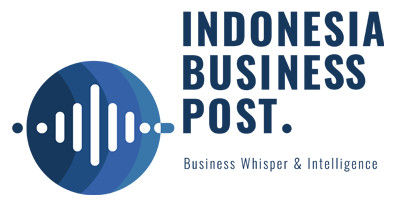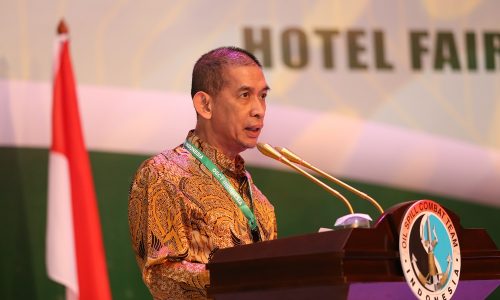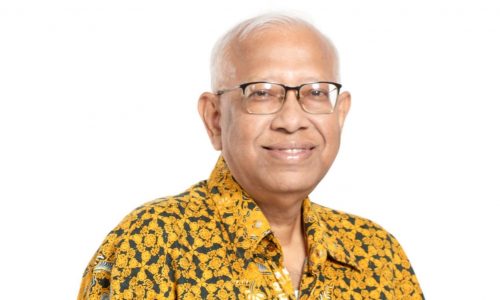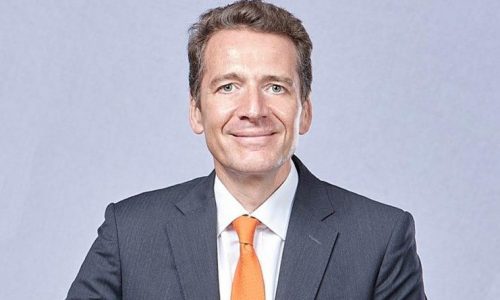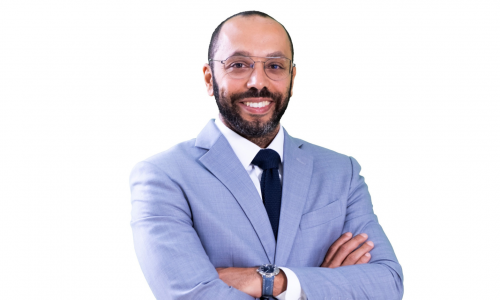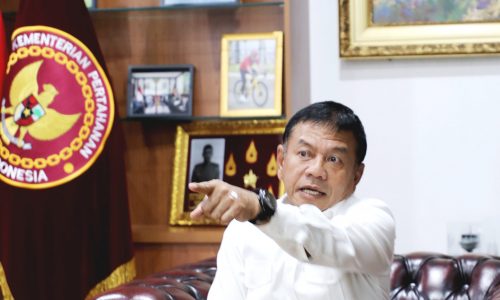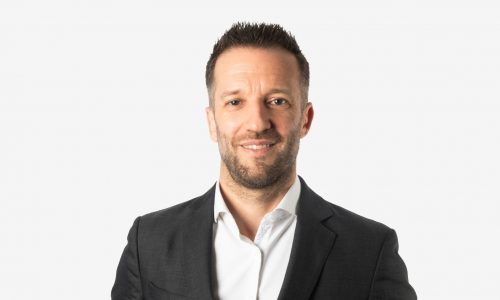Dr. Tb. Haeru Rahayu, A.Pi., M.Sc. currently serves as the Director General of Aquaculture at the Ministry of Marine Affairs and Fisheries of Indonesia. Rahayu is actively involved in international forums, such as being a speaker at the Bilateral Meeting with the Norwegian Agency for Development Cooperation (NORAD), Norway (2022), a speaker at The 35th Session of The FAO Committee on Fisheries (COFI), Italy (2022), a speaker at the 2nd World Ocean Summit Asia-Pacific, Singapore (2022), a delegate for the High-Level Dialogue Meeting between Indonesia and China (2023), and a speaker at The ASEAN Business and Investment Summit & AIPID Roadshow 2023, Australia (2023). Rahayu is an alumnus of the Fisheries College (1993), Ghent University, Belgium (2001), and earned his doctorate from Universitas Indonesia (2009).
Could you give us an overview of the Ministry of Marine Affairs and Fisheries (KKP) and your duties as the Director General of Aquaculture?
Our duties at the KKP are defined by the latest Ministerial Regulation No. 5 of 2024, which outlines the roles of each department. At the Directorate General of Aquaculture, our main task is to develop and implement policies for sustainable aquaculture management. This involves creating governance policies to enhance aquaculture practices.
How are these policies implemented?
We start by formulating management policies, detailed in the NSPK (Norms, Standards, Procedures, and Criteria). This covers the entire process, from planning to execution and evaluation.
Does this cover strategy to the operational level?
Yes, but our main role is regulatory. In practice, we can’t execute everything directly. We have to align with existing laws like the 2014 Regional Autonomy Law No. 23, which defines the authority of local governments. Local governments handle operations within their jurisdiction, while we focus on policy and strategic planning.
How are the operations being managed?
Operations are managed by local governments within their authority. For example, marine aquaculture up to 12 miles falls under provincial jurisdiction, while the inland aquaculture activities like shrimp farming are managed at the regency or city level. We provide guidelines and policies through regulations and the OSS system under the Omnibus Law.
How is the state budget (APBN) allocated for these activities?
The state budget is distributed from the President through the Ministry of Finance, which allocates funds to various KKP Directorates Generals, including aquaculture. This process usually involves coordination with Bappenas (National Development Planning Agency) or the Minister of National Development Planning. In the last 3-4 years, we have received around 6 trillion IDR annually. This funding is shared among all directorates generals and also allocated as assistance to local governments for specific tasks.
What are the key policies the KKP is implementing to manage fishing activities and ensure sustainable use of marine resources?
There are two main policies. First, we regulate fishing activities through a quota-based system to promote conservation and prevent overfishing while keeping our seas healthy. Since demand for fish increases with population growth, both globally and in Indonesia, we also focus on increasing supply through a second policy—developing sustainable aquaculture in inland, marine, and coastal areas. Additionally, preserving marine areas is crucial to achieving our third objective of protecting these ecosystems.
What is the current policy for aquaculture, and which commodities are being focused on for development?
Our aquaculture policy focuses on export-oriented development with five main commodities: shrimp, seaweed, tilapia, crab, and lobster. We’re also working on adding tuna to this list.
What are the two main strategies for developing aquaculture in Indonesia?
The first strategy is modelling, similar to what we have in Kebumen. This involves providing examples for aquaculture farmers to follow, helping them avoid environmental issues. The second strategy focuses on developing designated aquaculture villages. We have these villages mapped from Papua to Aceh, and we facilitate connections between investors and local governments. For instance, if a Chinese investor is interested in Bengkulu, Sumatra, we will connect them with the regional government there.
How does the current investment climate and political environment impact opportunities in Indonesia’s aquaculture sector?
The Job Creation Law aims to simplify bureaucracy and improve the investment climate. Politically, with the elected President continuing similar programs as his predecessors, the environment is stable. Regulations are in place, and while there may be some issues, we work to address them collaboratively.
Which five countries are the biggest investors in aquaculture?
China leads, followed by Vietnam. Japan is also significant, especially in tuna farming with Turkey. Turkey is preparing to start a project in Biak, expected to finalise this year and become operational next year.
What are the current incentives for investors?
Tax incentives include a holiday for pioneering industries like lobster farming, allowances under Government Regulation No. 78 of 2016, and VAT benefits under PP 49 of 2022 for both aquaculture and fish feed.
What challenges do most foreign investors face?
The main challenges are language barriers, which are now easily mitigated, and accessibility issues, particularly with logistics in eastern regions.
I did an interview with the Indonesian Ambassador in Tokyo, he mentioned a lack of cold storage facilities in Indonesia. Is that also a challenge?
Yes, cold storage is managed by the Directorate General for Enhancing Competitiveness within KKP. However, infrastructure issues, such as inadequate or unreliable electricity, pose a challenge.
Is offshore electricity available?
No, offshore electricity is not available. We are developing a 2,000-hectare shrimp farm in Waingapu, NTT, which is ten times the size of Kebumen. One major issue is electricity, and we are coordinating with PLN to address this.
Is Waingapu the only project for now?
Yes, Waingapu is currently the focus. It’s still in the planning stages, with construction expected to start next year and finish by 2025-2027. It’s a 2,000 hectares project, which is quite substantial. Once operational, it could produce around 53 million tons per year, significantly impacting foreign exchange and job creation. We also coordinate with other ministries to address various issues. For accessibility, we work with the Ministry of Transportation; for basic infrastructure like electricity, we collaborate with SOEs such as PLN (Perusahaan Listrik Negara) and ESDM (Ministry of Energy and Mineral Resources). For licensing, we coordinate with the Ministry of Home Affairs, as it involves district and municipal approvals, such as in Waingapu, East Sumba.
What’s the current status of the project?
The project is under Foreign Private Credit (KSA) and pending approval from the Minister of Finance. Once approved, it can move forward since the tender is complete. We need to follow a financial mechanism as relying only on the state budget (APBN) is not enough.
How big is the project?
It costs approximately IDR 7.1 trillion, based on an exchange rate of IDR 15,000.
How does the Ministry of Marine Affairs and Fisheries support innovation and technology in the aquaculture sector, and can you provide an example, such as in Waingapu?
The Ministry of Marine Affairs and Fisheries supports innovation in aquaculture by aiming to advance the sector with cutting-edge technology. Our goal is to reach the level of countries like Vietnam, where technologies such as the Internet of Things and Artificial Intelligence are used in aquaculture. And also for instance, in Japan, advanced water technology is employed to tailor the aquatic environment to the specific needs of the fish. In Waingapu, we are striving to implement similar innovations, though we’re still in the early stages. For example, we are working towards using technology to optimize water composition for different fish species, enhancing overall aquaculture practices.
Isn’t it already happening, since if it’s being exported, it must be of good quality?
Yes, we are progressing towards high-quality aquaculture. Traceability is becoming a standard requirement, and we are moving in that direction. Traditionally, we relied on natural and organic methods, but now we are enhancing our practices. For instance, we’re collaborating with Vietnam on the Tom Goksi technology, which involves oxygen-rich fish and shrimp farming. This is being implemented in Pinrang, South Sulawesi, and will be operational by early next year. Additionally, we’re working with Japan on a recirculating aquaculture system, which involves indoor shrimp farming to protect against external threats. This system is currently being tested at our unit in Karawang and developed in Niigata, Japan.
Does indoor shrimp farming align with European mandates for organic and free-range practices?
European standards can be quite idealistic, but we can’t dismiss technology outright. With increasing population and protein demand, technology is necessary due to limited land. Sustainable practices must be adopted, avoiding antibiotics and ensuring traceability. We’re developing models in places like Kebumen, Wakatobi, and Karawang to show effective practices. Technology is essential to meet future food needs, given the projected global population growth.
A lot of potential in the European market? American Market?
We face challenges entering the European market due to its strict regulations. Only about 177 companies have access to the European market due to their stringent regulations. Most of our shrimp exports currently go to the U.S. Compared to Europe. America’s regulations are less stringent, though we respect all rules. Japan is a strong market for fish, as are China, Hong Kong, and Vietnam. Vietnam often serves as a hub, purchasing products and then reselling them.
Is the Ministry of Marine Affairs and Fisheries working on transforming raw products?
Yes, the President has emphasized the need for downstream processing. We plan to reduce raw seaweed exports in the future, similar to what is being done with nickel and other commodities. We are working towards this goal.
What are the next plans?
Our next steps involve not just banning raw exports but also focusing on downstream processing. We plan to convert raw materials into semi-finished products and finished products, as well as encourage investors to establish industries locally. This approach aims to create jobs.
Isn’t this a great opportunity for investors to invest in Indonesia before downstreaming is fully implemented?
Absolutely. It’s a chance for investors to bring truly sustainable cultivation methods or fishing technologies while also providing educational value. It’s not just about enforcing bans but about making meaningful progress.Our population is expected to reach 285 million by 2030, with the global population at 8.3 billion. This will drive up demand for food and fish, making technological innovation essential. However, technology must meet five criteria: it should be replicable, reasonable, measurable, predictable, and environmentally friendly. For us, If it’s not environmentally friendly, then forget about it.
What measures are in place to ensure that fish farming practices comply with environmental and technological standards?
We use an international standard called Good Aquaculture Practices, which has been adapted here as CBIB (Cara Budidaya Ikan yang Baik – Good Fish Farming Practices). Fish farmers must meet this certification to receive a permit. If they don’t pass, they won’t be granted approval, but if they do, they can proceed. After certification, there is ongoing monitoring to ensure compliance; it’s not just a formality. If the standards are not adhered to, we have limited options for enforcement.
How does the Ministry of Maritime Affairs and Fisheries (KKP) foster collaboration between local industry players and international investors?
To foster collaboration, we ensure that all necessary conditions are met to attract investors. For example, in lobster farming, we partner with Vietnamese investors who provide the technology while we supply the lobster larvae (BBL). This partnership includes government-to-government discussions and MoUs. Additionally, we offer practical examples and models, such as our tilapia farming model, where we handle the preparations and facilitate investor involvement.
What kinds of partnerships are essential for advancing the aquaculture industry’s development?
We focus on partnerships that emphasize technology transfer and knowledge exchange. For instance, if we lack expertise in a specific field, we collaborate with countries like Japan. We might send interns there for training, and in return, they could invest in our industry. However, they are expected to provide their experts and share their technology. Additionally, for most jobs, we use our local workforce, except for specialised roles where local expertise isn’t available.
Do local communities gain access to high-quality products?
Yes, the quality is now dictated by the market itself. The days of lowering standards for local products compared to exports are over.
What are the future projections for Indonesia’s aquaculture sector over the next 5-10 years, and what are your expectations for its role in food security and economic growth?
I’m very optimistic about the future. The market potential is vast, particularly given the demand for just a few key commodities. With the human population on the rise, demand for food is increasing. Additionally, there is a growing awareness of health, as seen in Indonesia’s increasing life expectancy, now at 72 years. People are becoming more conscious of their lifestyle and diet, focusing on nutritious foods. Technological advancements, such as Industry 4.0 and AI, have enhanced efficiency, which further strengthens my optimism about the future of aquaculture in Indonesia.
What qualities do you value most in a person?
First and foremost, integrity is crucial; it’s the cornerstone upon which everything else is built. Without integrity, everything else is meaningless. Secondly, a strong will and motivation are vital; even if someone is honest, without drive, it’s hard to achieve much. Lastly, attention to detail is key. Our country needs individuals who are meticulous and not just going through the motions.
If you could have dinner with three people, whether living or dead, who would they be?
First, my mother, to whom I owe a lot for her sacrifices and would love to express my gratitude. Second, my eldest sibling, who gave up their own dreams to support our education. Lastly, my teacher, who had a profound impact on my life.
What inspired you to enter the fisheries sector?
Growing up in a village, I developed a love for fishing at an early age. This passion stuck with me and ultimately guided me toward a career in agriculture and fisheries.
Do you believe in fate?
Yes, as a person of faith, I believe in destiny. It’s a fundamental aspect of my religious beliefs.
